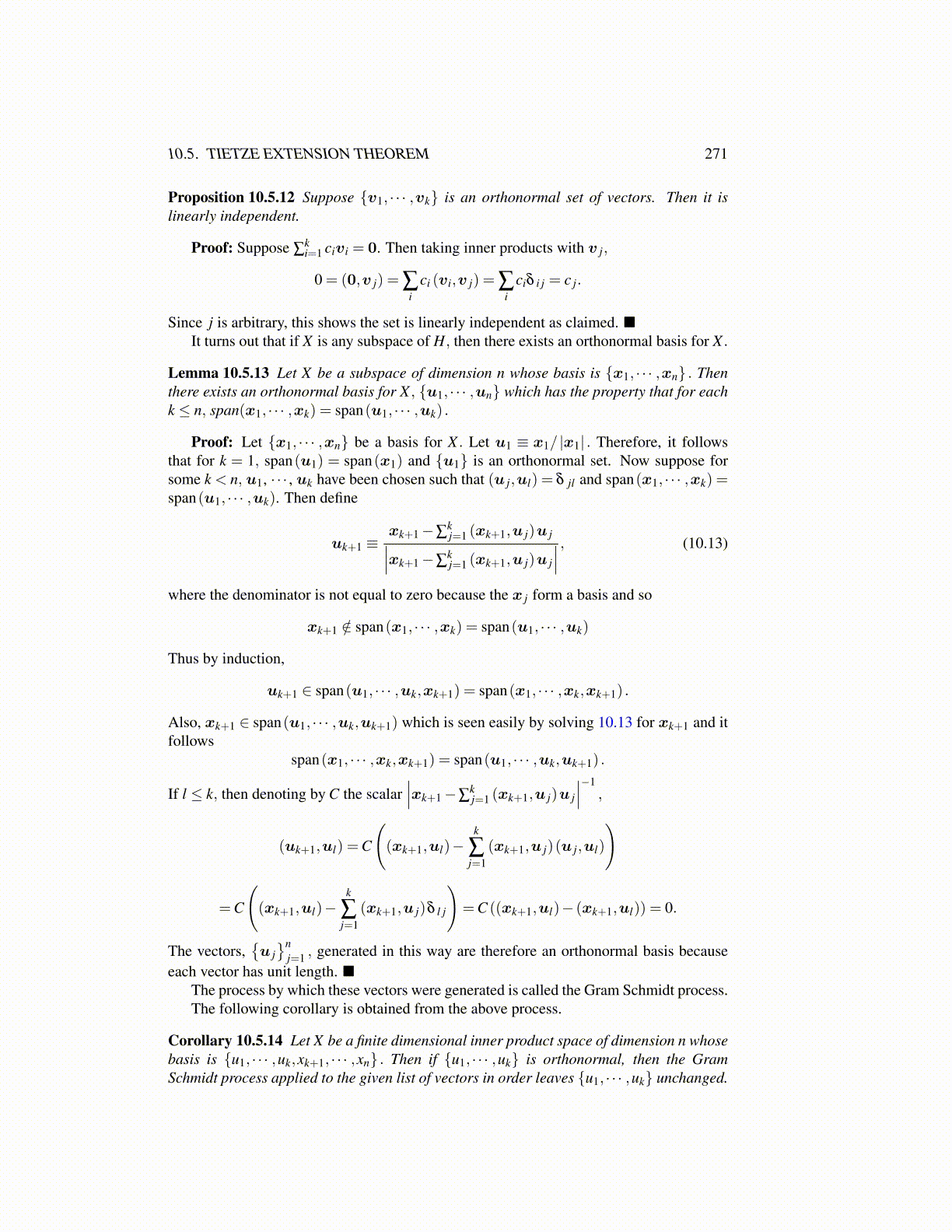
10.5. TIETZE EXTENSION THEOREM 271
Proposition 10.5.12 Suppose {v1, · · · ,vk} is an orthonormal set of vectors. Then it islinearly independent.
Proof: Suppose ∑ki=1 civi = 0. Then taking inner products with v j,
0 = (0,v j) = ∑i
ci (vi,v j) = ∑i
ciδ i j = c j.
Since j is arbitrary, this shows the set is linearly independent as claimed. ■It turns out that if X is any subspace of H, then there exists an orthonormal basis for X .
Lemma 10.5.13 Let X be a subspace of dimension n whose basis is {x1, · · · ,xn} . Thenthere exists an orthonormal basis for X , {u1, · · · ,un} which has the property that for eachk ≤ n, span(x1, · · · ,xk) = span(u1, · · · ,uk) .
Proof: Let {x1, · · · ,xn} be a basis for X . Let u1 ≡ x1/ |x1| . Therefore, it followsthat for k = 1, span(u1) = span(x1) and {u1} is an orthonormal set. Now suppose forsome k < n, u1, · · · , uk have been chosen such that (u j,ul) = δ jl and span(x1, · · · ,xk) =span(u1, · · · ,uk). Then define
uk+1 ≡xk+1−∑
kj=1 (xk+1,u j)u j∣∣∣xk+1−∑kj=1 (xk+1,u j)u j
∣∣∣ , (10.13)
where the denominator is not equal to zero because the x j form a basis and so
xk+1 /∈ span(x1, · · · ,xk) = span(u1, · · · ,uk)
Thus by induction,
uk+1 ∈ span(u1, · · · ,uk,xk+1) = span(x1, · · · ,xk,xk+1) .
Also, xk+1 ∈ span(u1, · · · ,uk,uk+1) which is seen easily by solving 10.13 for xk+1 and itfollows
span(x1, · · · ,xk,xk+1) = span(u1, · · · ,uk,uk+1) .
If l ≤ k, then denoting by C the scalar∣∣∣xk+1−∑
kj=1 (xk+1,u j)u j
∣∣∣−1,
(uk+1,ul) =C
((xk+1,ul)−
k
∑j=1
(xk+1,u j)(u j,ul)
)
=C
((xk+1,ul)−
k
∑j=1
(xk+1,u j)δ l j
)=C ((xk+1,ul)− (xk+1,ul)) = 0.
The vectors,{u j}n
j=1 , generated in this way are therefore an orthonormal basis becauseeach vector has unit length. ■
The process by which these vectors were generated is called the Gram Schmidt process.The following corollary is obtained from the above process.
Corollary 10.5.14 Let X be a finite dimensional inner product space of dimension n whosebasis is {u1, · · · ,uk,xk+1, · · · ,xn} . Then if {u1, · · · ,uk} is orthonormal, then the GramSchmidt process applied to the given list of vectors in order leaves {u1, · · · ,uk} unchanged.